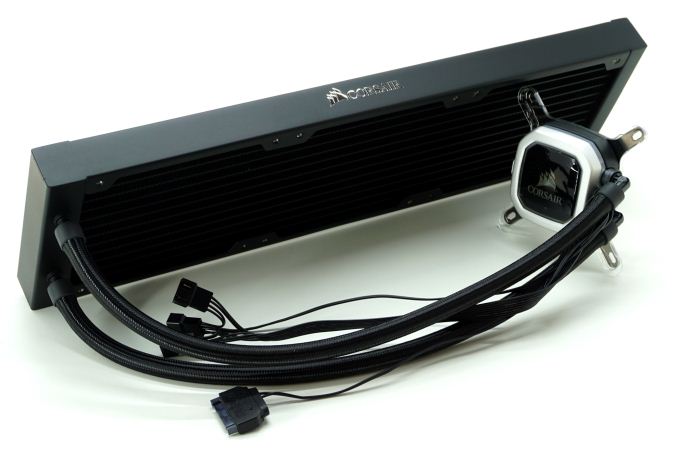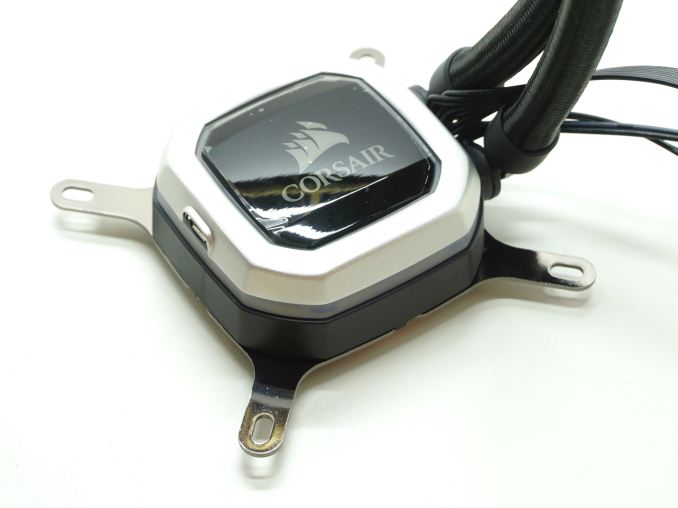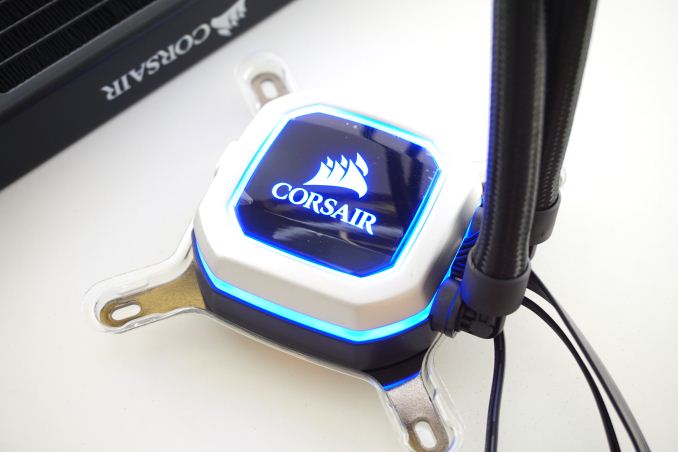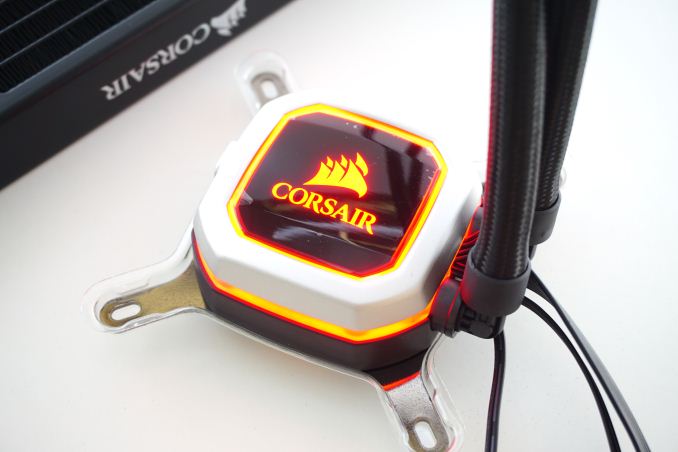The Corsair H150i Pro RGB AIO Cooler Review: The Quiet Giant
by E. Fylladitakis on August 16, 2018 8:00 AM ESTThe Corsair H150i Pro RGB
A single look at the H150i Pro RGB reveals how massive the cooler is. The radiator is so large that the hoses are not long enough for the block to reach its other end. The overall design is based on the common AIO cooler configuration of a single radiator, two hoses, and a single block that combines the copper CPU contact plate with a mini liquid pump. Such designs are usually using stiff corrugated tubing to prevent kinking but not this one, as Corsair went with thick-walled FEP (Fluorinated Ethylene Propylene) tubing with nylon sleeve braiding, which is more flexible and aesthetically superior.
Corsair designed the H150i Pro RGB to hold three consecutive 120 mm fans but the radiator itself is 400 mm long, requiring a case designed not only to hold three 120 mm fan in the row but also with enough space to fit a liquid cooling radiator. The massive radiator is a classic dual pass cross-flow design with tiny fins soldered on the thin oblong tubes. Despite its massive length, the radiator of the H150i Pro RGB is not actually very thick. It is just 27 mm thick, meaning that a total clearance of at least 55 mm is required using the stock 120 mm fans and taking into account the 3 mm screw heads. It is obvious that the designer of the H150i Pro RGB intended it to be usable with low speed fans, so the airflow resistance of the radiator had to be kept low.
The main block assembly of the H150i Pro RGB is jestingly small when compared to the massive size of its radiator. It is a very small assembly by any comparison, considerably shorter than the vast majority of AIO blocks that we have seen to this date. Most of the assembly is made out of plastic, with an octagonal body and a circular base. A silver frame surrounds the piano-black top with the company's logo. The rest of the plastic body is black, with chromed metallic parts. The block is powered via a SATA connector and has a 3-pin motherboard connector that serves only as a tachometer for speed/health monitoring. A flat cable that ends to three fan connectors also exits the block, for the power, monitoring, and control of the three radiator fans.
The copper contact plate is attached to the circular base of the block with eight screws. Although it is not machined to a perfect mirror finish, it is very smooth and perfectly flat, which is what matters for good thermal performance. Thermal material is applied to it and it comes with the Intel CPU mounting retention bracket from the factory. A retention bracket for AMD CPUs is included in the bundle. There was no bracket for AMD's Ryzen Threadripper processors inside the box of our sample but Corsair now mentions that the H150i Pro RGB does support AMD's Ryzen Threadripper processors, plus an extra TR4 mounting bracket part appeared in their website.
Corsair installed RGB lighting into the block. Once the H150i Pro RGB is powered, the company's logo and a ring surrounding the block will illuminate. The lighting colour and effects are programmable via Corsair's iCUE software if the USB cable is connected to one of the motherboard's internal USB 2.0 headers.
The new iCUE software is very flexible and allows for the interconnection of any compatible device, inside and outside the case. It is also possible to program the lighting colors to have a practical meaning, such as programming variable lighting colors for different CPU (or other) temperature readings. For example, you can set your Corsair K95 Platinum's keyboard lighting to blink red if the processor's temperature surpasses a certain point while, and even have the computer shut down if the temperature is sustained above a threshold for X seconds.























42 Comments
View All Comments
tamalero - Sunday, August 19, 2018 - link
Good for you man, but anecdotal evidence isnt exactly a basis for fact.Many people never had Xboxes fail on them, does not means others did.
Hell, my cousin had more than 10 CONSECUTIVE xbox failures (as in replacements) during the Xbox design BS.
Shlong - Friday, August 24, 2018 - link
It doesn't matter if it's anecdotal evidence or not. There is no evidence that AIO's have a high failure rate. The failure rate reported is like 0.01%. The Xbox comparison isn't apt because that had a high failure rate.FullmetalTitan - Friday, November 16, 2018 - link
It would be one thing if the risk he was pointing out was that AIOs will fail somewhat stealthily, but whatever cooling method you are using you will definitely notice the first time your PC hits a BSOD for CPU over temp. Troubleshooting both takes exactly one failure to identify the problem.On the xbox note, I was actually pretty happy I got the red ring naturally because MS had just changed it's warranty policy like the week before, got an upgrade from the janky first shipment of 360s to the newer version with better power management/safer power brick.
loadbang - Monday, August 27, 2018 - link
Have put together into boxes with i9 and an H150i with four 1080Ti's installed. I was surprised at how quiet the whole box was, the client ended up having the rendering PCs in their office rather than the comms room. You can pretty much let the fans idle at the slowest speeds, CPUs are pretty happy running up to 100ºC, this AIO gets temps well below that.TEAMSWITCHER - Thursday, August 16, 2018 - link
I read somewhere that a custom PC manufacturer switched to all-in-one water coolers to eliminate problems they had in shipping. Large heavy heatsinks would damage the motherboard when the package they were shipped in received a sharp impact. Computers that worked fine before shipping were broken by the time they reached the customer. This article prompted my switch to water cooling.mkaibear - Thursday, August 16, 2018 - link
That would make sense if you move your computer a lot, but most people build it and leave it in one place...Cableaddict - Friday, June 28, 2019 - link
I've been taking oc'd PC's on the road for about 20 years now. Water cooling scares me to death, even today. As the air coolers got larger, I did start having problems with micro-cracks in my mobos.Then I came up with a simple solution: I run a length of angle aluminum across the top of the rack case, then I use plastic ties to secure the Noctua cooler to the aluminum. Dead solid. I haven't had a mechanical failure in at least 6 years, with 3 PC's getting thrown around my truck several times a week. With my new i9x build, I'm finally considering an AIO, but it would have to offer more than just a 10% improvement.
Diji1 - Friday, August 17, 2018 - link
Yeah but how quiet is that top of the line air cooler with 100 CPU load?Diji1 - Friday, August 17, 2018 - link
*100% evenApharot - Monday, June 10, 2019 - link
Keeping it cool at 100% load is far more important than noise level. I'll take cooler over quieter every time.